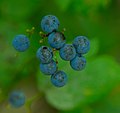| Caulophyllum thalictroides | |
|---|---|
 | |
| Scientific classification | |
| Kingdom: | Plantae |
| Clade: | Tracheophytes |
| Clade: | Angiosperms |
| Clade: | Eudicots |
| Order: | Ranunculales |
| Family: | Berberidaceae |
| Genus: | Caulophyllum |
| Species: | C. thalictroides |
| Binomial name | |
| Caulophyllum thalictroides | |
Caulophyllum thalictroides, the blue cohosh, is a species of flowering plant in the Berberidaceae (barberry) family. It is a medium-tall perennial with blue berry-like fruits and bluish-green foliage. The common name cohosh is probably from an Algonquian word meaning "rough".[ citation needed ] The Greek-derived genus name Caulophyllum signifies "stem-leaf", while the specific name thalictroides references the similarity between the large highly divided, multiple-compound leaves of meadow-rues ( Thalictrum spp.) and those of blue cohosh.












